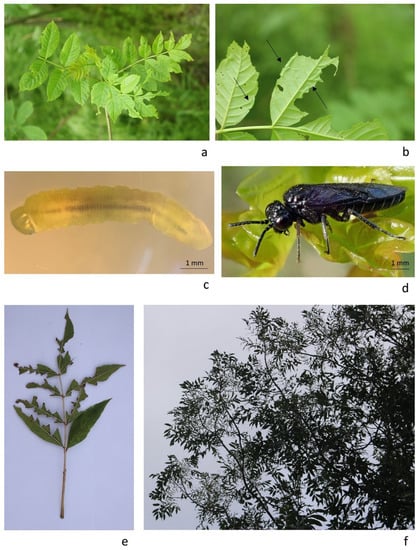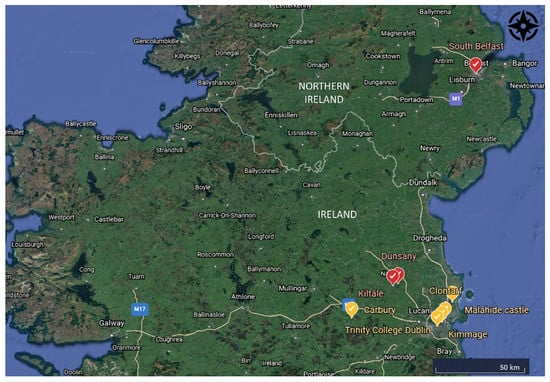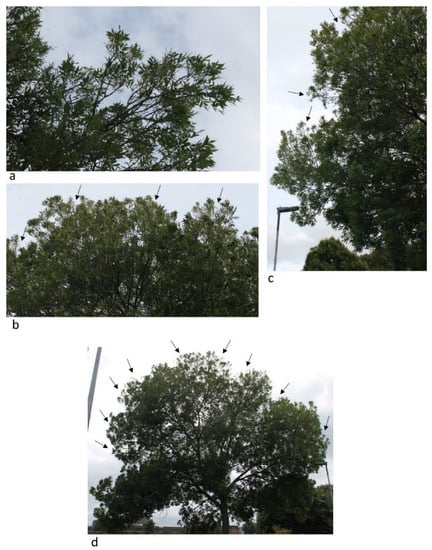Simple Summary
Ash sawfly, Tomostethus nigritus, larvae feed on the leaves of Fraxinus excelsior. In the last 20 years, outbreaks of these insects have become more common, and they cause severe defoliation of the tree crown. This pest is native to Europe, and it was recorded for the first time on the island of Ireland in Belfast, Northern Ireland (UK) in 2016. This article is the first report of T. nigritus in the Republic of Ireland (IE). Damaged leaves and larvae were observed on ash trees in Co. Kildare in summer 2021. The larvae were collected and then identified using molecular analyses. Similar damaged leaves were observed on trees in Co. Dublin, which showed mild defoliation of the crown. However, severe defoliation of ash trees has also been recorded in Co. Meath in 2021. No control treatments are available against the insects, and little is known about the cause of the outbreaks. Severe outbreaks by T. nigritus could further affect the delicate situation that the Irish ash tree population is currently facing caused by another severe antagonist of Fraxinus, the ash dieback pathogen Hymenoscyphus fraxineus.
Abstract
This is the first report of the ash sawfly, Tomostethus nigritus, in the Republic of Ireland. We observed defoliated leaves of Fraxinus excelsior L. and T. nigritus larvae at a forestry plantation in Co. Kildare. Morphological observation of the larvae and DNA analysis using mitochondrial COI barcoding confirmed the identification of this pest of ash.
1. Introduction
Tomostethus nigritus (Fabricius, 1804) is a Euro-Siberian species that is distributed throughout many parts of Europe [1]. This species was seldomly associated with severe defoliation of ash trees (Fraxinus excelsior) and it was generally present in low densities in urban areas in Western Europe [1,2]. However, severe outbreaks have been intensifying over the last 30 years and severe defoliation of ash trees has been observed in countries such as Austria (1974, 1977, 1999) [3,4]; Belgium (2016 onward) [2]; Croatia (1997–2001) [5]; Czech Republic (1965, 1999–2000) [6,7]; Finland (2015 onwards) [8]; Germany (1993, 1994) [9]; Italy (North Italy: Friuli Venezia Giulia (2000–2009), Lombardia (1980–2007), Veneto (2012-?), Trentino Alto Adige (2008–2009)) [10,11]; Norway (1990–1995) [12]; Republic of Moldova (2018, 2019) [13]; UK (London (1993) [14], Manchester (2010) [15], Telford (2014) [15], Scotland (2014) [15], Northern Ireland (2016 onwards) [1]); and Ukraine (2002, 2012–2014) [16]. Adults are visible around mid-April/May and they deposit their eggs within the ash leaves. Once the larvae hatch, they eat the leaves until middle summer and then they migrate to the soil where they pupate and survive winter [1] before emerging as adults the following spring. There is a single generation per year.
This pest was previously recorded to only attack F. excelsior species, however, a new report by Verheyde et al. (2019) demonstrated that the ash sawfly can also cause damage on F. angustifolia Vahl [2]. T. nigritus was first observed on the island of Ireland in Northern Ireland in 2016, where it is still active in the Belfast area [1]. However, until now, Tomostethus nigritus has not yet been reported in the Republic of Ireland.
2. Materials and Methods
2.1. Biological Material
Damaged leaves and larvae were first observed at the beginning of July 2021 in an ash tree forestry plantation in Carbury, Co. Kildare, Ireland. The ash plantation, which covers an area of 7000 m2, is surrounded mainly by a golf club and a spruce plantation. Leaves and larvae samples were collected and stored at 4 °C until subsequent genomic DNA extraction and sequencing in the laboratory. Only larvae and not adults were apparent in June.
2.2. DNA Isolation and Analysis
Extraction of the genomic DNA from the larvae was carried out using the CTAB protocol as described by Hodkinson et al. (2007) [17,18]. PCR amplification was conducted using primers for the cytochrome oxidase subunit 1 (COI) gene, a mitochondrial barcode region used for the identification of insects. LCO1490 (5′-GGTCAACAAATCATAAAGATATTGG-3′) and HC02198 (5′-TAAACTTCAGGGTGACCAAAAAATCA-3′) [19] primers were used for amplification. The cycling parameters were modified from Ashfaq et al. (2019) [20] and were as follows: 1.15 min at 94 °C; 35 cycles of 45 s at 94 °C, 1 min at 52 °C, 1 min at 72 °C; and a final cycle of 7 min at 72 °C.
The PCR product was purified using the ExoSAP-IT™ PCR Product Cleanup Reagent (Thermo Fisher Scientific, Waltham, MA, USA). The final products were sequenced in both directions using either the forward and reverse primer used in the PCR and the Sanger Sequencing Service offered by Source Biosciences (https://www.sourcebioscience.com/home (accessed on 13 July 2021)). The forward and reverse trace files were used to assemble a consensus sequence of 658 bp for each sample using Geneious Prime V. 2021.1.1. The consensus sequence obtained was then analysed using nucleotide-nucleotide BLAST (BLASTn) against the National Centre for Biotechnology Information (NCBI) GenBank database (https://www.ncbi.nlm.nih.gov/ (accessed on 9 September 2021)).
2.3. Morphological Observation and Imaging
Morphological observations and imaging of the T. nigritus samples were obtained using a dissection microscope. In situ photographs of the T. nigritus samples and defoliated ash trees were taken with a CANON EOS 100D or 1100D camera and EFS 18–55 mm lens.
3. Results
The larvae were observed on regenerated ash tree leaves (sample code: FeL21Du1-3) and on leaves of a 30-years-old ash tree (sample code: FeL21Du4) (Figure 1a). The larvae were present on the underside of the leaf on a branch at a distance of one to two meters from the ground floor (Figure 1b). Only the main vein of the leaf remained intact and attached to the branches due to the feeding of the larvae (Figure 1e,f). The sawfly larvae were olive green in colour and caterpillar-like and matched the description of Mrkva (1965) for T. nigritus [6]. There were mixed instars on the leaves but those observed measured approximately 7 mm in length (Figure 1c).

Figure 1.
Tomostethus nigritus in the Republic of Ireland. (a,b) Leaves damaged by T. nigritus on F. excelsior in Co. Kildare and observation of larvae on the underside of the leaves (indicated by the black arrows) (Carbury, Co Kildare, Ireland, 08.VI.21, photo A.M.M. Tiley); (c) image of T. nigritus larvae (Trinity College Dublin, Dublin, Ireland, 09.VI.21, photo E. Fuller; (d) adult of T. nigritus observed in Belfast (NI) (Belfast, UK, photo A.K. Murchie); (e,f) detail of defoliated ash leaves by T. nigritus in Co. Dublin. Only the main vein of the leaf remained intact and attached to the branches (Kimmage, Dublin, Ireland, 17.X.21, photo A.M.M. Tiley).
The mitochondrial cytochrome oxidase gene was successfully amplified and sequenced. The resulting sequences were deposited in GenBank (Table 1, GenBank Accession). The amplicon had a length of 658 bp, which matches the predicted amplicon size [19]. The results from the BLASTn analysis demonstrated that the assembled sequences obtained in this study have a similarity of over 99.8% with the highest NCBI match, which was T. nigritus (Table 1, in bold). Other queries obtained from the BLASTn analysis have a pairwise similarity of below 92.10% (Table 1, not in bold). These species have a high pairwise similarity with the sequences obtained from this study because they also belong to the sawfly family Tenthredinidae, suborder Symphyta and order Hymenoptera. Combined, these results therefore confirm that the larvae isolated are identifiable as T. nigritus.

Table 1.
Summary of nucleotide-nucleotide BLAST (BLASTn) results of samples obtained in this study (FeL21Du1–FeL21Du4) against the NCBI database. BLASTn matches in bold indicate the closest match between the GenBank Accession sequence and Reference Query sequence. BLASTn matches not highlighted in bold have less similarity between the GenBank Accession sequence and Reference Query sequence.
4. Discussion
Co. Kildare is the first location where T. nigritus has been confirmed in the Republic of Ireland. The first recorded observation of this pest on the island of Ireland was in Belfast (Northern Ireland) in 2016 [1]. At first, T. nigritus caused severe defoliation on a moderate number of trees and since then an increasing number of ash trees have been completely defoliated by the larvae during the subsequent years [1]. Our observations in Co. Kildare were limited to a small number of trees affected by this insect. Similar mild symptoms affecting the top or the side crown of ash trees (Figure 1e,f and Figure A1) have also been observed by ourselves in urban locations (parks and along canals) in Co. Dublin (Figure 2) during 2021. As explained by Meshkova et al. (2017), different microclimates within the crown could influence larvae and shoot development. This could therefore explain why the insects tended to prefer lower or upper leaves of the crown in different geographic locations [21].

Figure 2.
Distribution of observed Fraxinus sp. attacked by T. nigritus in the Republic of Ireland and Northern Ireland. Trees that shown mild defoliation of the crown are marked in yellow, whereas those with severe defoliation are marked in red.
Severe defoliation of ash trees was recorded at a woodland in Co. Meath by a local news article in July 2021 (https://www.meathchronicle.ie/2021/07/15/ash-sawflies-eating-way-through-meath/, last accessed on 15 October 2021)) but identity was not confirmed. However, this research is the first to confirm the presence of T. nigritus in the Republic of Ireland using a combination of observational and molecular evidence. According to the newspaper source, the insects were present in such high densities that the larvae were falling from the trees “like rain”. The authors speculate that the ash sawflies may have been introduced in Co. Meath in previous years, perhaps transported from Northern Ireland to the Republic of Ireland.
Adult sawflies have been seen clinging to clothing of cyclists and walkers on the Lagan towpath in Belfast and it is plausible that they could be carried on sheltered parts of cars and lorries in the same manner. The spread in the Belfast area certainly follows parts of the road network. The late spring and subsequent late flushing of ash trees, followed by unusually high temperatures in June and July 2021, could have triggered the severe defoliation observed in Co. Meath. As Verheyde and Sioen (2019) suggest, synchrony between the development of the ash sawfly larvae and the host is the main factor which leads to severe defoliation [2]. Future monitoring of the progress of ash sawfly on the Island of Ireland could help to clarify these speculations.
Ash sawfly, T. nigritus, were considered a sporadic pest until now, and little is still known about the factors governing outbreaks. Flooding and insect parasitism are believed to act as natural regulation factors of the ash sawfly population [2,5], but parasitoids attacking T. nigritus have not yet been found in Ireland. Global warming and subsequent closer synchrony of insect and plant development are considered to be the main cause of recent widespread outbreaks [2,5,16] but the hypothesis remains to be tested.
Severe outbreaks of ash sawflies do not kill the ash tree, which tends to recover. However, consecutive defoliations might result in reduced vigour [21,22]. A weakened tree can also become vulnerable to more severe threats, such as ash dieback disease caused by the fungus Hymenoscyphus fraxineus [22]. Ash dieback is already present on the island of Ireland and it is a major threat to the ash tree population [23]. The combination of ash dieback with the outbreaks of ash sawflies could acerbate even further the already precarious situation of the ash tree population in Ireland. It is therefore crucial to continue monitoring plant health on the Island of Ireland. In addition, it is important to remain vigilant of other threats that could be introduced, such as the emerald ash borer (Agrilus planipennis Fairmaire), which could annihilate any effort for recovering and maintaining the Irish ash population on the island.
Author Contributions
Conceptualization, E.S. and A.M.M.T.; methodology, T.R.H.; formal analysis, E.F. and T.R.H.; resources, T.R.H.; data curation, E.S.; writing—original draft preparation, E.S.; writing—review and editing, E.S., A.M.M.T., T.R.H. and A.K.M.; supervision, T.R.H.; funding acquisition, T.R.H. All authors have read and agreed to the published version of the manuscript.
Funding
This research was funded by DAFM and DAERA grant number 2019R578, Nexcelsior: Next Steps in managing the impact of ash dieback project.
Data Availability Statement
DNA sequences are deposited in GenBank under accession numbers OK493754-OK493757 and in the BOLD system under sequences ID GBMNE1845-21-GBMNE1842-21.
Acknowledgments
We thank Ciaran Duggan for access to his land for collection of the samples used in this study. AKM thanks DAERA, Northern Ireland, for support (E&I project no. 18/3/08).
Conflicts of Interest
The authors declare no conflict of interest. The funders had no role in the design of the study; in the collection, analyses, or interpretation of data; in the writing of the manuscript, or in the decision to publish the results.
Appendix A

Figure A1.
Defoliation of leaves by T. nigritus in Trinity College Dublin, Co. Dublin, Republic of Ireland. (a–d). The insect defoliated only the apical leaves of the crown on (b) top, (c) left and (d) right side (indicated in picture by the black arrows) (Trinity College Dublin, Dublin, Ireland, 16.IX.21, photos by E. Soldi).
References
- Jess, S.; Murchie, A.; Allen, D.; Crory, A. First observation of Tomostethus nigritus (Fabricius) (Hymenoptera: Tenthredinidae) on urban ash trees in Ireland. Irish Nat. J. 2017, 35, 134–136. [Google Scholar]
- Verheyde, F.; Sioen, G. Outbreaks of Tomostethus nigritus (Fabricius, 1804) (Hymenoptera, Tenthredinidae) on Fraxinus angustifolia ‘Raywood’ in Belgium. J. Hymenopt. Res. 2019, 72, 67–81. [Google Scholar] [CrossRef]
- Pschorn-Walcher, H.; Altenhofer, E. Langjährige Lärvenaufsammlungen und Zuchten von Pflanzenwespen (Hymenoptera, Symphyta) in Mitteleuropa. Linzer Biol. Beiträge 2000, 32, 273–327. [Google Scholar]
- Pschorn-Walcher, H. Unterordnung Symphyta, Pflanzenwespen. In Die Forstschädlinge Europas; Schwenke, W., Ed.; Paul Parey: Hamburg/Berlin, Germany, 1982; Volume 4, pp. 232–234. [Google Scholar]
- Matošević, D.; Hrašovec, B.; Pernek, M. Spread and character of Tomostethus nigritus F. outbreaks in Croatia during the last decade. Ecol. Surv. Manag. For. Insects Proc. 2003, 311, 39–43. [Google Scholar]
- Mrkva, R. Prispevek k morfologii, bionomii a poznani parazitu pilatky jasanove (Tomostethus nigritus F.). Pr. Vyzk. Ust. Lesn. Čssr. Zbraslav-Strnady 1965, 30, 35–64. [Google Scholar]
- Liška, J.; Holuša, J. Listožravý hmyz. In Výskyt Lesních Škodlivých Činitelo v České Republice v Roce 2000 a Jejich očekÁvaný Stav v roce 2001; Kapitola, P., Kníek, M., Eds.; Zpravodaj Ochrany Lesa 2000 (Suplementum); 2002; pp. 28–38. Available online: https://www.silvarium.cz/lesnictvi/vyskyt-lesnich-skodlivych-cinitelu-v-roce-2020-a-jejich-ocekavany-stav-v-roce-2021 (accessed on 13 July 2021). (In Czech)
- Nevalainen, S.; Nuorteva, H.; ja Pouttu, A. (toim.). Metsätuhot vuonna 2017. In Luonnonvara-ja Biotalouden Tutkimus 44/2018; Luonnonvarakeskus: Helsinki, Finland, 2018; 48p, ISBN 9789523266216. [Google Scholar]
- Taeger, A.; Altenhofer, E.; Blank, S.M.; Jansen, E.; Kraus, M.; Pschorn-Walcher, H.; Ritzau, C. Kommentare zur Biologie, Verbreitung und Gefährdung der Pflanzenwespen Deutschlands (Hymenoptera, Symphyta). In Pflanzenwespen Deutschlands (Hymenoptera, Symphyta); Taeger, A., Blank, S., Eds.; Kommentierte Bestandsaufnahme, Goecke & Evers: Keltern, Germany, 1998; pp. 49–135. [Google Scholar]
- Mitali, E. Indagini sul Defogliatore del Frassino Tomostethus nigritus (Hymenoptera Tenthredinidae). Master’s Thesis, Universitá degli Studi di Padova, Padua, Italy, 2012; pp. 1–59. Available online: http://tesi.cab.unipd.it/41149/ (accessed on 8 December 2021).
- Salvadori, C.; Maresi, G.; Pedrazzoli, F.; Bitussi, D. Forest Protection Situation in Trentino (Northeastern Italy) in 2008–2009. Forstsch. Aktuell 2010, 55, 21–23. [Google Scholar]
- Austarå, Ø. Severe outbreaks of the ash sawfly Tomostethus nigritus F. (Hymenoptera: Tenthredinidae) on ornamental trees in oslo. Anz. Schädlingskd Pflanzenschutz Umweltschutz 1991, 64, 70–72. [Google Scholar] [CrossRef]
- Nadejda, M. Tomostethus nigritus F. (Hymenoptera, Tenthredinidae)—A new pest species of ash tree in the Republic of Mol-dova. Olten.-Stud. Si Comun. Stiint. Nat. 2020, 36, 90–95. [Google Scholar]
- Cheke, R.; Springate, N. Nest desertion by blackbirds following defoliation of an ash tree by sawfly larvae. Br. J. Entomol. Nat. Hist. 1999, 12, 13–16. [Google Scholar]
- Stockan, J.; Taylor, A.F. An outbreak of Tomostethus nigritus (F.) (Hymenoptera: Tenthredinidae) on Aberdeen’s urban ash trees. Br. J. Entomol. Nat. Hist. 2014, 27, 190–191. [Google Scholar]
- Davydenko, K.V.; Meshkova, V.L. European ash (Fraxinus excelsior) dieback-situation in Europe and Ukraine. For. Hortic. 2014. Available online: http://journals.nubip.edu.ua/index.php/Lis/article/view/9868 (accessed on 13 July 2021).
- Hodkinson, T.R.; Waldren, S.; Parnell, J.A.N.; Kelleher, C.T.; Salamin, K.; Salamin, N. DNA banking for plant breeding, biotechnology and biodiversity evaluation. J. Plant Res. 2007, 120, 17–29. [Google Scholar] [CrossRef] [PubMed]
- Soldi, E.; Casey, C.; Murphy, B.; Hodkinson, T. Fungal Endophytes for Grass Based Bioremediation: An Endophytic Consortium Isolated from Agrostis stolonifera Stimulates the Growth of Festuca arundinacea in Lead Contaminated Soil. J. Fungi 2020, 6, 254. [Google Scholar] [CrossRef] [PubMed]
- Folmer, O.; Black, M.; Hoeh, W.; Lutz, R.; Vrijenhoek, R. DNA primers for amplification of mitochondrial cytochrome c oxidase subunit I from diverse metazoan invertebrates. Mol. Mar. Biol. Biotechnol. 1994, 3, 294–299. [Google Scholar] [CrossRef] [PubMed]
- Ashfaq, M.; Blagoev, G.; Tahir, H.M.; Khan, A.M.; Mukhtar, M.K.; Akhtar, S.; Butt, A.; Mansoor, S.; Hebert, P.D.N. Assembling a DNA barcode reference library for the spiders (Arachnida: Araneae) of Pakistan. PLoS ONE 2019, 14, e0217086. [Google Scholar] [CrossRef]
- Meshkova, V.; Kukina, O.; Zinchenko, O.; Davydenko, K. Three-year dynamics of common ash defoliation and crown condition in the focus of black sawfly Tomostethus nigritus F. (Hymenoptera: Tenthredinidae). Balt. For. 2017, 23, 303–308. [Google Scholar]
- AFBI Plant Health Factsheet: Ash sawfly Tomostethus nigritus (Fabricius). 2016. Available online: https://www.afbini.gov.uk/news/ash-sawflies-active-belfast-area (accessed on 3 September 2021).
- Lahiri, A.; Murphy, B.; Hodkinson, T. Assessing Genotypic and Environmental Effects on Endophyte Communities of Fraxinus (Ash) Using Culture Dependent and Independent DNA Sequencing. J. Fungi 2021, 7, 565. [Google Scholar] [CrossRef] [PubMed]
Publisher’s Note: MDPI stays neutral with regard to jurisdictional claims in published maps and institutional affiliations. |
© 2021 by the authors. Licensee MDPI, Basel, Switzerland. This article is an open access article distributed under the terms and conditions of the Creative Commons Attribution (CC BY) license (https://creativecommons.org/licenses/by/4.0/).